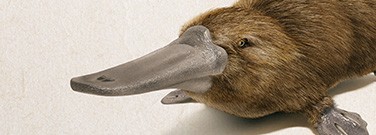It’s a Bird! It’s a Beaver! How Evolution Shaped the Duck-Billed Platypus

By Gina Wynn
A fascinating animal, the duck-billed platypus is an obscure creature that has both duck- and beaver-like characteristics. In short, it’s a furry, brown mammal with a billed snout that lays eggs. How did platypuses get to be such an anomaly? A team of international researchers led by the University of Copenhagen got some answers by investigating the platypus genome. Their findings are published in Nature.
By definition, mammals are warm blooded, produce milk to nourish their young, and have bodies covered with hair, a hinged jaw, and three tiny middle ear bones. Most mammals give birth to live offspring and possess specialized teeth. But platypuses are part of an exclusive egg-laying, toothless group called monotremes — along with the echidna — native to Australia, New Guinea, and Tasmania.
Genetically Unique
Because Australia, New Guinea, and Tasmania broke away from Antarctica and became islands millions of years ago, monotremes — considered a more primitive type of mammal — enjoyed a peaceful existence for a long time without being exposed to more advanced mammal competitors. This geographic isolation enabled the monotremes to thrive so we can appreciate them today and learn from their rich genetic history.
Scientists have been curious about the unique features of the platypus since Europeans discovered them in the late 1700s. The river dwellers also sweat milk, have fur that is fluorescent in UV light, and determine sex with 10 chromosomes. In addition, they have webbed feet for swimming and venomous spurs behind the males’ back legs for defense in territorial battles.
Ancestral Connections
After mapping the platypus genome using advanced gene sequencing technology, the research team gained insight into platypus reproduction. They learned that platypuses carry both vitellogenin and casein genes that enable both egg laying and milk production for feeding offspring. Typically, vitellogenin is only present in bird species and casein in other mammals.
“It informs us that milk production in all extant mammal species has been developed through the same set of genes derived from a common ancestor which lived more than 170 million years ago — alongside the early dinosaurs in the Jurassic period,” said University of Copenhagen Biologist Guojie Zhang according to an American Association for the Advancement of Science news release.
Evolutionary Links
The study also revealed that the platypus’s closest ancestors had teeth, but four of the eight genes for tooth development disappeared from their genome approximately 120 million years ago. The team also determined that the platypus’s 10 sex chromosomes have more in common with chickens than humans.
“Indeed, the platypus belongs to the Mammalia class. But genetically, it is a mixture of mammals, birds, and reptiles,” said Guojie Zhang. “It has preserved many of its ancestors’ original features — which probably contribute to its success in adapting to the environment they live in.”
Though currently a protected species and classified by the International Union of Conservation of Nature as near-threatened, the duck-billed platypus’s ability to adapt and evolve over time presents an unparalleled opportunity for scientists: Our duck-billed friends from Down Under may hold the key to our understanding of human evolution.
Discussion Questions
- What other mammals live in Australia and nearby islands that have unique characteristics that aren’t shared by many other mammals?
- What do you call mammals that carry their young in pouches?
- Why do you think they are mostly found in and around Australia?